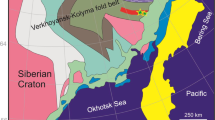Abstract.
A large number of Variscan mesothermal gold deposits are located in the central part of the Bohemian Massif, close to the Central Bohemian Plutonic Complex. The Petráčkova hora deposit has many features that distinguish it from other deposits in the region and suggest its mineralization is closely related to the late magmatic processes associated with the Petráčkova hora granodiorite. The gold ores occur as sheeted arrays of quartz veins and veinlets hosted by the small Petráčkova hora granodiorite stock. Gold is found mainly as free grains of >900 fineness, and is accompanied by abundant pyrrhotite and chalcopyrite, and accessory pyrite, arsenopyrite, loellingite, and molybdenite. Molybdenite from the Petráčkova hora deposit has been dated by the Re–Os method at 344.4±2.8 Ma. Hydrothermal alteration in the Petráčkova hora deposit exhibits a distinct temporal paragenesis. Selectively pervasive, early K-alteration and silicification are the oldest hydrothermal phases. These were followed by early quartz veins (Q1 to Q4) that contain most of the gold mineralization. Late quartz veins (Q5) and fracture-controlled silicification are gold-poor or barren. Barren calcite veins are the youngest hydrothermal product. Extensive low-temperature, meteoric-water dominated alteration, as is typical of classic porphyry deposits, is absent. However, the lower δ18O whole rock values for Petráčkova hora granodiorite and aplite (+2.4 to +5.1‰ SMOW) compared to other intrusions in the region reflect either interaction with isotopically light external fluids or magma assimilation of small volumes of hydrothermally altered country rock. The δ18O isotopic compositions for quartz, scheelite and hornblende (7.7 to 13.4‰ SMOW) and the δ34S compositions for sulfide minerals (–1 to +3.5‰ CDT) from early, gold-rich quartz veins indicate formation at high temperatures (590 to 400 °C) from fluids with a magmatic isotopic signature (δ18OFLUID of 5.7 to 7.2‰). Fluids related to late quartz veins (Q5) suggest the presence of a significant component of non-magmatic water (δ18OFLUID: +2.5 to +4.0‰). The δ34S values of post-Q5 sulfide minerals (–4.5 to –3.5‰) reflect at least partial derivation of late-stage sulfur from a source external to the intrusions. Aqueous, aqueous–carbonic and nitrogen-bearing fluid inclusions were identified in hydrothermal and igneous quartz, with the aqueous inclusions being the most common. In hydrothermal vein quartz, the salinity of primary aqueous inclusions falls into ranges 6 to 23 and 33 to 41 equiv. wt% NaCl; in igneous quartz, populations in salinity were observed between 5 to 16, 35 to 40 and 62 to 70 equiv. wt% NaCl. The salt component of these fluids is best, and minimally, approximated by the NaCl–KCl–CaCl2 system. Low- and high-salinity aqueous–carbonic inclusions are accessory in many of the analyzed samples. Three large successive pulses of fluids are recognized. Each pulse begins with a high-salinity (>30 equiv. wt% NaCl) magmatic fluid and evolves toward a lower salinity (~5 equiv. wt% NaCl) fluid. Data suggest that external (meteoric?) water(s) were significant for only the third fluid pulse, which formed the late Q5 quartz veins and the calcite veins. Polyphase fluid inclusions hosted by igneous quartz of the Petráčkova hora granodiorite indicate minimum trapping conditions of about 3 kbar and 550 °C. The gold-rich Q1 to Q4 veins may have formed along a quasi-isobaric cooling path at 2.5 to 1.5 kbar and 590 to 400 °C. This was followed by uplift, and formation of late Q5 quartz veins (0.5 to 1.5 kbar; ~300 °C) and post-ore calcite veins (<0.5 kbar; 100 to 140 °C). The characteristics of the Petráčkova hora deposit suggest that it may represent a position intermediate between intrusion-related gold systems (e.g., Fort Knox deposit, Alaska) and gold-rich, copper-poor porphyry deposits (e.g., Maricunga Belt in Chile). As such, the Petráčkova hora deposit might be an example of the reduced gold sub-type of porphyry deposit.
Similar content being viewed by others
Author information
Authors and Affiliations
Additional information
Electronic Publication
Rights and permissions
About this article
Cite this article
Zachariáš, J., Pertold, Z., Pudilová, M. et al. Geology and genesis of Variscan porphyry-style gold mineralization, Petráčkova hora deposit, Bohemian Massif, Czech Republic. Min Dep 36, 517–541 (2001). https://doi.org/10.1007/s001260100187
Received:
Accepted:
Issue Date:
DOI: https://doi.org/10.1007/s001260100187




